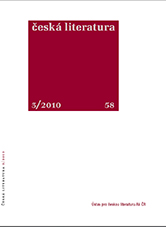„Rührung, rühren, rührend“ (Pražské přednášky Augusta Gottlieba Meißnera v kontextu německé estetiky 18. století)
‘Rührung, rühren, rührend’: The Prague Lectures of August Gottlieb Meißner in the Context of Eighteenth-century German Aesthetics
Author(s): Tomáš HlobilSubject(s): Literary Texts
Published by: AV ČR - Akademie věd České republiky - Ústav pro českou literaturu
Keywords: Meißner; August Gottlieb; Enlightement; Prague University; aesthetics
Summary/Abstract: The terms Rührung, rühren, rührend, and gerührt occur with extraordinary frequency in the lectures on aesthetics and poetics which were given at Prague University by August Gottlieb Meißner (1753–1807), as recorded by his students Josef Jungmann and Josef Liboslav Ziegler. The article aims to explain how Meißner, the ordinarius of aesthetics and classical literature at Prague, worked with these terms in his lectures and it seeks to demonstrate how their use was connected with the Enlightenment aesthetics of the eighteenth century, particularly in the German-speaking lands. The ennoblement of this set of terms in aesthetics at Prague University in the late eighteenth and early nineteenth centuries was probably not based on any specific work. Instead, it was connected with the general aesthetic trends of the times, particularly the influential German ‘aesthetics of effect’ (Wirkungsästhetik) of the second half of the eighteenth century. This current, which constituted an alternative to the contemplatively conceived transcendental aesthetics of Immanuel Kant, made the emotions the basis of taste and art, adding a psychological-anthropological aspect to aesthetic thinking, without losing sight of the importance, even paramouncy, of the moral contribution of art. Meißner’s lectures constitute a hitherto unknown, hard to overlook part of this current of German aesthetics, which was developed at a university in the Austrian Monarchy, that is to say, beyond the frontiers of the traditional central German and north German centres of aesthetic thought. Though the concentrated interest in Rührung places Meißner’s lectures into this current, the absolutization of the term, resulting in a deliberate weakening of the moral aspect, shifts the lectures to the margins. The double role of Rührung, the most typical, most distinctive feature of the lectures, shows that Meißner was familiar not only with contemporaneous German views but also with the strikingly more pointed French and English viewpoints, which he had absorbed probably during his years at Leipzig.
Journal: Česká literatura
- Issue Year: 58/2010
- Issue No: 3
- Page Range: 293-316
- Page Count: 24
- Language: Czech

